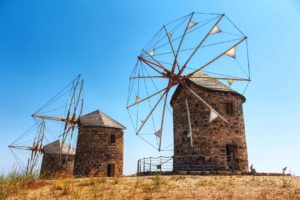
In New Heights, the windmills are more than just scenery, so let’s delve into them a little more!
The Lasithi plateau in Eastern Crete is famous for its windmills, as is the island of Mykonos. There were once ten thousand windmills on the plateau, though only a fraction remain. These dotted the landscape like pinwheels, with their triangular jib sails.
Panemone windmills were first developed in Eastern Iran in the 9th century. These windmills’ sails rotated in a horizontal plane around a vertical access, using sails of cloth or reed matting. Later post mills were in use in Europe in the 12th century; these used vertical orientation of the sails and allowed the body of the mechanism to be mounted on a central post which could pivot to face into the wind. By the end of the 13th century, tower mills made of masonry became the standard, in which only the cap rotated to face the wind. They were more powerful, because they could be taller. In some locations, the cap was fixed, since the wind direction was relatively constant. These windmills were efficient, because the mill did not have to be stopped to winch the cap around to face the wind.
One interesting aside I learned is that in the Netherlands, the stationary position of the sails has been used to signal. If the configuration of the still blades is a “+” sign (at the 3/6/9/12 o’clock position), it means the mill is open for business. An “X” configuration means the mill is closed or non-functional. A tilt to the right, with the top blade at 1 o’clock, signals joy, such as for the birth of a healthy baby. A tilt to the left, to 11 o’clock signals mourning or danger. Such signals were used during Nazi operations to signal searches for Jews, and as recently as 2014, mills were configured this way for the victims of the Malaysian Airlines Flight 17 shootdown.
The Greek windmills were used for water or grain; a few were double mills, which did both. A xetrocharchis mill has a cylindrical shape; an axetrocharchis mill is rectangular with a curved, semi-circular front face. The grain mills caused a millstone to turn (the runner), grinding against a stationary stone (the standing stone) below it. Grain was poured through holes in the stone, and flour leaked out the sides to be collected in a chute and bagged. Mills had multiple floors, allowing separation of the grain, final products, and various parts of the mechanism. Depending on the wind speed and size of the millstones, a mill might grind 300-500 lbs of flour per hour, of which the miller’s cut was customarily ten percent.
If you want to read more about grain mills in operation, here’s a wonderful site to check out: http://www.angelfire.com/journal/millrestoration/millstones.html
Many of the ancient Greek windmills are being restored and converted into other uses, like bed and breakfasts, though the one featured in New Heights was used for something else entirely!
Windmills have been featured extensively in literature, from Don Quixote, to Henry IV, to Animal Farm. Now we can add New Heights to that list! Here’s a fun site that contains many poems and other references to windmills in literature: https://tringlocalhistory.org.uk/Windmills/c_chapter_15.htm#:~:text=The%20most%20famous%20episode%20in,the%20waving%20arms%20of%20giants.
Nice article. Is the picture posted above from the Lashti Plateau?
I was looking at the “blades” on the windmill, they remind me of self furling sails. The lines that reach from the tip of the central hub to the tip of the blade (‘sail”) being the line that unrolls them.
But good stuff.
Hi, thanks for your comments! Some of the designs do have sails that furl via various mechanisms. These are not on the Lasithi plateau but are similar in style.
Wow, who knew?
I thought there were two kinds of windmills, dutch windmills to look pretty, and California windmills to air-condition the cows. And never would have guessed they could be used for communication. Fascinating stuff!
Thanks for your comments! This is one thing I love about writing, all the new things I learn! Glad you enjoyed the post!